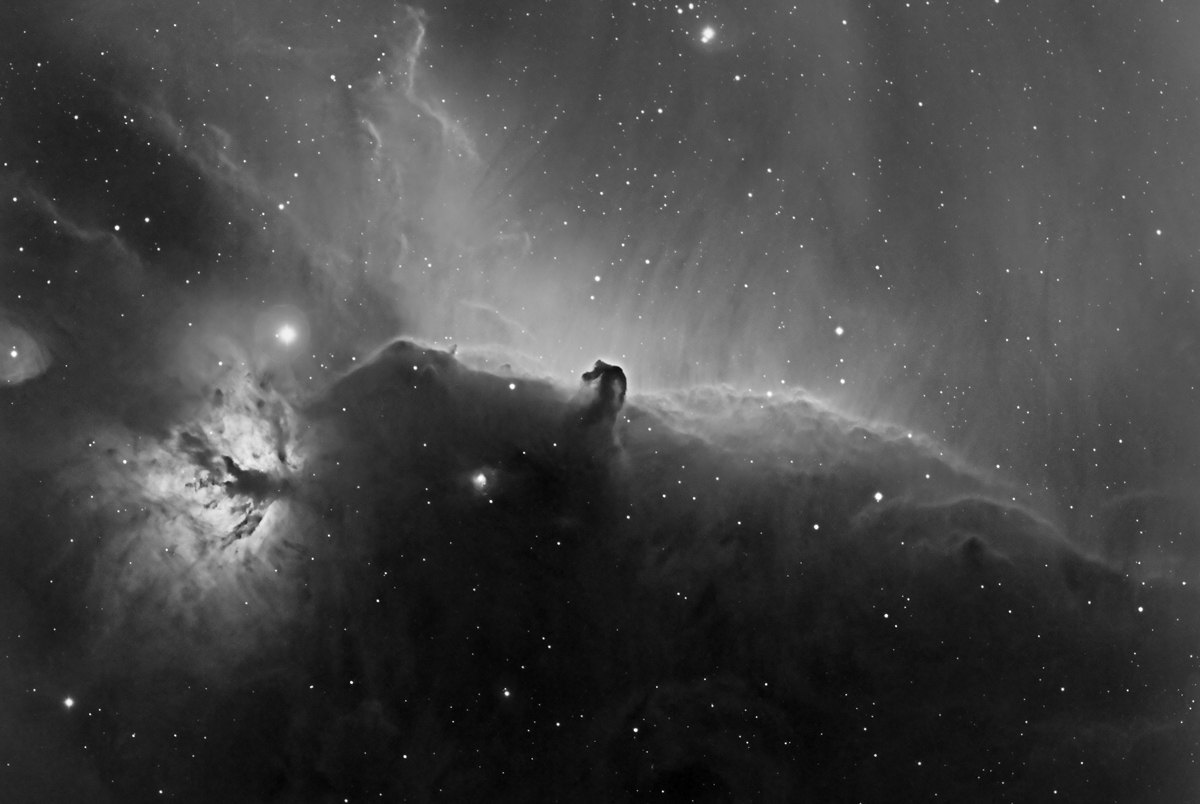 |
The Horsehead Nebula Region in Hydrogen-Alpha light
 |
Copyright 2009 Hap Griffin
Many of the areas
of the sky appear dark in photographs not because of a lack of stars or glowing
nebulae, but because of great lanes of obscuring dust between our vantage point
and the objects beyond. Such is the case with the Horsehead Nebula shown
here...the most famous of all dark nebulae, and known as B33. The dust is
the remnant of an older generation of stars that long ago died in great nova and
supernova blasts spreading the heavy elements they synthesized from primordial
hydrogen during their lives back into space. Spectral analysis reveals
that the dust is composed largely of silicon, carbon and oxygen.
The Horsehead
figure is actually a dynamic structure formed by the protrusion of a dense area
of the larger dust cloud that can be seen at its base. It lies in front of
and obscures an area of red glowing hydrogen, IC434. Parts of the
base dust cloud can be seen partially obscuring the bright blue reflection
nebula NGC2023 at the lower left. The structure is huge...between
12,000 and 13,000 of our own solar systems could be spread out across it's
"neck". It is theorized that the Horsehead itself is a "Bok
Globule" which will eventually break free from the main cloud and condense
into individual stars. Examples of Bok Globules can be seen in the Rosette
Nebula HERE.
The "Flame" Nebula, NGC 2024, dominates the left side of the photo. The
bright star above it is Alnitak, the leftmost star in Orion's belt. Below
and to the left of the Horsehead is the reflection nebula NGC 2023.
B33 lies at a distance of 1500 light
years.
This image was captured through a narrowband filter admitting only a narrow
slice of spectrum around the wavelength of glowing hydrogen. Thus it is a
monochrome (single color) image displayed as shades of grey.
Date/Location:
November 14, 2009 Griffin/Hunter
Observatory Bethune, SC
Camera: QSI 583wsg
Filters: Astrodon E Series Generation 2 HA (5nm BW)
CCD Temperature: -20 C
Instrument: Takahashi FSQ-106N
Focal Ratio: f/5
Mount: AP-1200
Guiding: Auto through Orion 10" Newtonian w/ SBIG ST-402
Conditions: Passing high cirrus and heavy dew
Weather: 50 F, still
Exposure: 180 minutes total (9 x 20 min)
Capture: CCDAutopilot 4 w/ Maxim DL Camera Control, focused automatically w/
FocusMax and Robofocus.
Processing: Frame calibrations, alignment, initial DDP with ImagesPlus v3.80.
Finishing in Photoshop CS4.